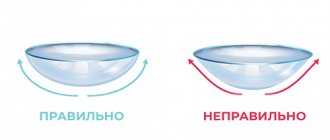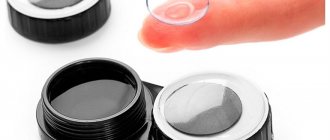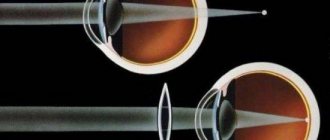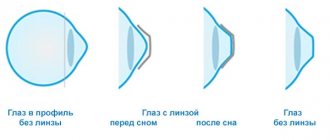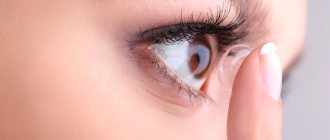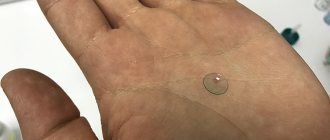Types of contact lenses
There are 2 types of contact vision correction devices:
- hard;
- soft.
Rigid lenses are manufactured to correct visual dysfunction for therapeutic purposes. They are suitable for daily wear, but cause a lot of inconvenience. To improve visibility of the surrounding world, it is preferable to use soft contact lenses.
Daily lenses allow for maximum hygiene of use
Soft - made from materials:
- hydrogel (qualities - breathability, streamlining, elasticity);
- silicone hydrogel (oxygen permeability, resistance to external changes).
Vision correction devices are distinguished by wearing mode:
- daytime (used only during periods of vigor);
- flexible (can be used at night, but extremely rarely);
- long-lasting (worn without removal for several days);
- continuous (without replacement up to 1 month).
Unless absolutely necessary, it is better not to use continuous wear lenses. They are suitable only for a certain category of patients. Before installation, you must undergo an examination by an ophthalmologist to ensure there are no contraindications.
Protection and nutrition of the visual organ - Katachrom eye drops.
Improper care can cause infection
Also, contact lenses are divided into 2 categories.
Standard (to be used within six months) and scheduled replacement.
Planned replacement, in turn, is divided into:
- daily (taken before nighttime);
- two weeks;
- 30 days;
- 90-day.
Each type is selected individually, depending on the indicators of eye health. The shorter the wearing period, the:
- safer (less likely to be damaged);
- healthier (more moisture);
- lower risk of infection;
- lower formation of deposits (complete absence).
The use of lens care products allows you to maintain their original condition during prolonged wear.
To prevent and treat dry eye syndrome, use Cationorm eye drops.
Color correction products will help you quickly change your look
Soft vision correction devices have different purposes depending on the needs of patients. They are divided into several categories.
Optical:
- spherical (for correction of myopia and farsightedness);
- toric (for astigmatists);
- multi- and bifocal (to eliminate presbyopia).
Colored cosmetic (changing the shade of the iris).
These 2 types can be combined with each other: optical lenses are also available with a color effect.
Storage boxes
Why keratometry is performed, read the link.
How to prepare to wear
Before making a choice in favor of contact means of vision correction, you must consult an ophthalmologist. He will conduct a full eye examination and determine:
- optical characteristics;
- deviations in the health of the visual organs.
Brief instructions for a beginner
In some cases, contact lenses are contraindicated:
- the presence of severe strabismus;
- minimal sensitivity of the upper shell of the eye;
- disruption of natural tear production;
- AIDS;
- tuberculosis;
- conjunctivitis and keratitis;
- glaucoma;
- lacrimation, burning in the eyes and other symptoms of various pathologies.
After making sure that there are no abnormalities listed above, the patient is given a prescription for soft contact lenses. Next comes the selection of wearing mode and brand.
Some patients who want to use contact vision correction for the first time are recommended to take a course of instilling moisturizing drops. They will prepare the eyes for the installation of a foreign body and increase the production of natural tears.
Contact lenses should not be used during acute respiratory diseases and eye infections. This creates a risk of local inflammatory processes. During treatment it is necessary to use glasses.
A dangerous disease that requires immediate treatment is corneal keratopathy.
OK Vision
How to treat and whether a conjunctival cyst is dangerous for vision is described in detail in the article.
Devices that facilitate the process
To simplify putting on the CL, you can use a hand-held suction cup. It guarantees the integrity of the product and ease of dressing.
To put on the CL:
- Squeeze the suction cup and bring it to the lens, releasing the pressure slightly. The vision correction product will stick to the suction cup.
- Without pulling your eyelids back, lean it against your eye.
- Squeeze the suction cup, releasing the pressure in it - the lens will push away from the suction cup and remain on the eye.
To remove the CL:
- Place moisturizing drops into your eyes to ensure mobility of the vision correction product.
- Pull back the lower and upper eyelids with your index finger and thumb.
- Bring the compressed suction cup to your eye at a right angle.
- Release the pressure slightly and the lens will stick to the device.
- Remove it from the eye.
- Release the pressure in the suction cup, the vision correction device will come unstuck and you can put it back into the container.
Following the instructions will help you figure out how to put your lenses on for the first time and how to remove them correctly. As you understand, there is nothing terrible or complicated in this procedure, but if after reading all the recommendations you still don’t succeed, then you should consult an ophthalmologist for help.
Author: Anton Frolov, especially for Okulist.pro
Tips for choosing
To select contact lenses, you must adhere to some rules:
- Diagnosis and prescription processing should only take place at an optician or medical facility.
- During selection, you need to try on several pairs of products. You need to spend at least 20-30 minutes in each to understand how comfortable the world around you is perceived.
- The installation should not cause discomfort, the feeling of a foreign body in the eye and cause increased lacrimation.
- The wearing mode is selected individually. For dry eyes, it is better to purchase daily or bi-weekly options. If you are planning a business trip, you may additionally need long-term vision correction devices.
- Visual acuity should be checked every six months. It is better to do this in the same place where the lenses were selected.
The article is for informational purposes only. To select contact lenses, you must consult an ophthalmologist.
Note to young mothers - strabismus in newborns Komarovsky.
Before choosing a product brand, it is important to obtain advice from a qualified specialist.
Why iris coloboma can occur and how to deal with it, find out here.
Method one. Using inscriptions
Many lenses (such as Johnson & Johnson) have numbers or some kind of inscription on one side. In this case, you need to place the product on the tip of your finger and look carefully at this inscription. If you see several numbers (for example, “12345”, but in exactly the correct sequence), then everything is correct. And if you see a kind of mirror image of these numbers, then the product is turned inside out.
If the inscription is legible, then the side was chosen correctly
But there are also models that do not have any inscriptions. Here you need to use one of the following options.
Video: How to determine the correct side of the lenses?
How to use - step-by-step instructions on how to easily insert and remove
Installation of lenses occurs in several stages (it doesn’t matter whether they are colored products or for vision correction):
- Wash your hands and dry them with a lint-free cloth.
- Open the container containing the solution.
- Use your working hand to remove the lens.
- Using the fingers of your working hand, pull down the lower eyelid. With your other hand, lift the top one.
- Put the lens on while looking up. Direct your gaze straight.
- Blink several times to ensure proper alignment.
- Repeat for the second eye.
Lenses must be put on and taken off all the time, starting with the same eye. This will not allow you to confuse vision correction products of different diopters.
Antiglaucoma therapy with a high-quality drug - instructions for Combigan eye drops.
Memo
Removing lenses:
- Use the index finger of your working hand to move the vision correction device to the side.
- Using a pinching motion, remove the lens.
- Place it in a container with solution (for long-term wear) or throw it away (for daily lenses).
It is important not to confuse the back and front sides of the lens. You need to bring it to the light, holding it on your finger with the edges facing up. If they are bent outward, then the lens needs to be turned out. This must be done carefully to avoid ruptures and damage.
Preparation
Before you start using lenses, you need to prepare tools to make putting them on easier. You need to get in advance:
- Wet sanitary napkins if it is not possible to wash your hands.
- A mirror that you don't need to hold in your hands.
- Special tweezers with soft rubberized or silicone tips.
- Sami KL.
- Cleaning solution selected based on the material of the corrective agent so as not to spoil it. It is strictly forbidden to use running water instead of a special solution; this can lead to eye infection. Read more about lens solutions →
- Moisturizing eye drops.
If you do not have daily lenses in individual packaging, but reusable ones, then they need to be disinfected. To do this, they must be kept in a container with a special solution, usually for more than 4 hours (the instructions indicate the exact number of hours).
The person putting on the CL should clean their hands well with tissues or wash them with soap. Wait until dry or wipe with a towel that does not leave lint on your hands. Before putting on, you need to check the lens for defects or dirt. If damage is detected, it is necessary to purchase a new vision correction device; under no circumstances should you wear a damaged one. If contamination is detected, they are removed using a solution prepared in advance.
It is important to remember that you should not confuse the lens for the left and right eyes; to do this, always start on the same side and store the contact lens in a special container marked L (Left) and R (Right).
Is it painful to put it on for the first time and the problem of “reflexes”
There should be no painful sensations during either the first or subsequent installations of contact lenses. The norm is only a slight feeling of discomfort. It is not recommended to wear vision correction for the whole day at once. You need to start with a couple of hours, gradually increasing the time interval.
During the installation of the lens, an unconditioned reflex occurs when the cornea of the eye and a foreign body collide - blinking. As a result, tear fluid is released, which interferes with proper fit. This situation disappears as you get used to the lenses.
When using contact lenses, you must use specialized moisturizing drops. A regular substitute for natural tears will not work, as it contains components that are deposited on the surface of the vision correction product.
One drug, double action against bacteria and inflammation - Combinil Duo eye drops.
Rules of care
Find out how to choose an artificial eye lens here.
What happens if you put your lenses on inside out?
Out of habit, it can be difficult to determine which side should be adjacent to the cornea. In the correct position, the product has an even sphere shape; on the wrong side, the edges stretch slightly in height and width. In the latter case, sensations in the eye area change. There is a stinging and burning sensation, discomfort, which makes you want to get rid of the incorrectly worn vision corrector.
How to properly remove lenses that are worn inside out? The process is practically no different from the usual one. The optics move away from the mucous membrane easier and faster.
Proper care
Daily contact lenses must be disposed of after removal. All others must be cared for, adhering to certain rules:
- Before starting any manipulations, you must thoroughly wash your hands with antibacterial soap.
- The disinfectant solution in the container must be changed strictly every day.
- After removal, they must be treated with a special solution.
- If it sticks, you should not try to straighten it. You need to apply a couple of drops of moisturizing liquid. The same procedure must be followed in case of a fall.
- After pouring the solution, the container is dried in the open air. It needs to be changed regularly.
BAUSCH + LOMB
The first experience of wearing contact lenses should begin with a visit to the ophthalmologist. He will determine the diopter value and diagnose the individual characteristics of the eyes. Depending on this data, the selection of lenses is made.



